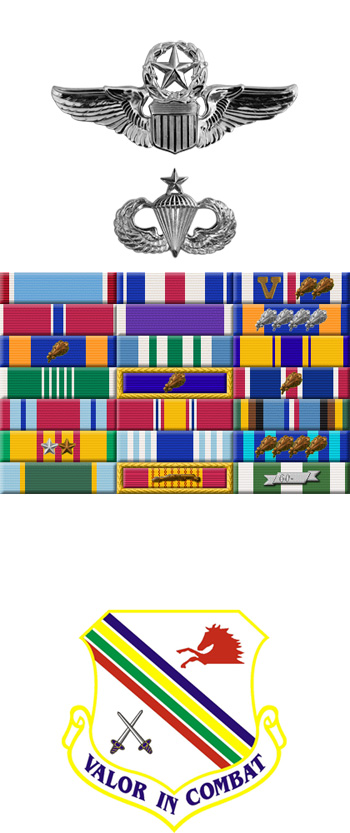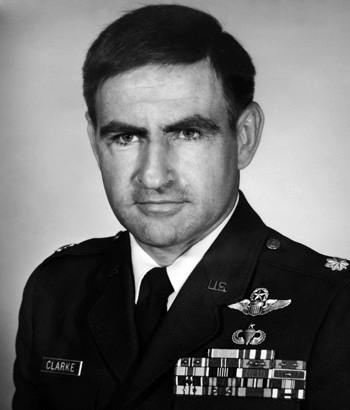
|
Colin Arnold Clarke |
 |
|||
| Rank, Service | ||||
Lieutenant Colonel O-5, U.S. Air Force |
||||
| Veteran of: | ||||
|
||||
| Tribute: | ||||
Arnie Clarke was born on August 31, 1935, in Seattle, Washington. He enlisted in the U.S. Naval Reserve on January 3, 1954, and was trained as an Electronics Technician. Clarke completed his bachelor's degree in Marketing from the University of Washington in 1958, and received an honorable discharge from the Naval Reserve on May 3, 1960, in order to attend Air Force Officer Training School. He was commissioned a 2d Lt in the U.S. Air Force at Lackland AFB, Texas, on August 9, 1960, and completed Undergraduate Pilot Training and was awarded his pilot wings at Williams AFB, Arizona, in September 1961. Lt Clarke next completed F-100 Super Sabre Combat Crew Training and then served with the 522nd Tactical Fighter Squadron (TFS) at Cannon AFB, New Mexico, from October 1962 to May 1965. During this time, he deployed to Southeast Asia in support of the Vietnam War two times, first from December 1962 to February 1963, and then again from August 1964 to February 1965, flying 27 combat missions in the process. Capt Clarke then transferred to the 77th TFS at RAF Wethersfield, England, where he served until July 1968, when he again deployed to Southeast Asia. He flew 285 combat missions with the 352nd TFS at Phan Rang AB and later from Phu Cat AB in the Republic of Vietnam between July 1968 and July 1969, flying the F-100, O-1 Bird Dog, OV-10 Bronco, OH-6 Cayuse, and one mission in a Navy F-4J Phantom II flying off the USS Ranger (CV-61). During this time, Clarke volunteered as a Misty FAST FAC from January to July 1969. After returning from Vietnam, Maj Clarke served as an Air Liaison Officer with the U.S. Army's 82nd Airborne Division at Fort Bragg, North Carolina, from August 1969 to May 1971. He then completed A-7 Corsair II Combat Crew Training and served with the 356th TFS of the 354th TFW at Myrtle Beach AFB, South Carolina, from May 1971 to March 1974. During this time, he deployed to Southeast Asia as an A-7 Sandy pilot, where he flew an additional 73 combat missions from Korat Royal Thai AFB, Thailand, between October 1972 and March 1973. During his 385 combat missions in Southeast Asia, Clarke was shot down and rescued twice, first on August 18, 1964, and a second time while flying as a Misty FAC on January 22, 1969. His next assignment was as an Air Force Advisor to the 185th Tactical Fighter Group of the Iowa Air National Guard from March 1974 to July 1978, and then as Chief of the Joint Operations Branch, Air Force Operations and Training Division, of the Military Assistance Advisory Group in Tehran, Iran, from July 1978 to February 1979, when he was evacuated due to the Iranian Revolution. Col Clarke's final assignment was as Chief of Current Operations with Headquarters 17th Air Force at Sembach AB, West Germany, from February 1979 until his retirement from the Air Force on August 1, 1981. After his retirement from the Air Force, Arnie managed Pangborn Memorial Airport in East Wenatchee, Washington, for many years. Col Clarke was MISTY 89. Arnie Clarke died on December 13, 2010, and was buried at Tahoma National Cemetery in Kent, Washington. |
||||
|
||||

